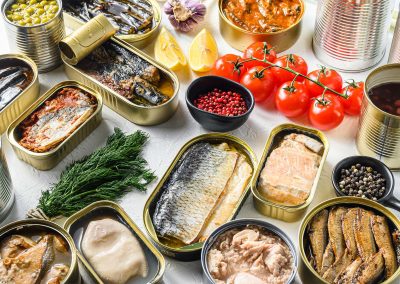Ready to go!
How did canned fish become an ideal companion?
Ready to go!
You planned an active day in nature and you need food that can meet your needs.
We love a situation when the easiest is, in fact, the best.
Let's see how and why canned fish became an ideal companion for every adventure.
If we go back to 1809, we will see that after many experiments, the Frenchman Nicolas Appert, at the request of Napoleon's new government, which badly needed a way to ensure a stable supply of its large army, invented the process of preserving food. His method was based on the idea of food in bottles and glass jars that were heated to a certain temperature and then, once heated, stored for some time, after which they were tightly sealed and stored until use.
The Englishman Peter Durand patented the use of tin containers instead of glass bottles in 1810.
European method of preserving food quickly spread throughout the United States of America, so that country soon became the world leader in this business. With numerous technical innovations, they improved the canning process and automated the production method.
At the end of the 19th century, Samuel C. Prescott and William Underwood from the United States of America set canning on a scientific basis by describing specific time-temperature heating requirements for sterilizing canned foods.
Canneries are usually located close to the growing areas of the product to be packed, since it is desirable to can foods as quickly as possible after harvesting.
The process of canning Stari Beograd products consists of several stages:
- cleaning and further preparation of raw food materials
- filling the containers (nowadays usually under a vacuum) vakumom)
- closing and sealing the containers
- sterilizing the canned products
- labelling and
- warehousing the finished goods
The filling of cans is done manually or automatically by machines. Cans are filled with solid contents and with an accompanying liquid (brine and oil) in order to replace as much of the air in the can as possible. The filled cans are then passed through a hot water or steam bath. This heating expands the food and drives out the remaining air so that after sealing, heat sterilizing, and cooling the can, the contraction of the contents produces a partial vacuum within the container.
Immediately after the cans are exhausted, a machine places the cover on cans. The sealed cans are then sterilized, i.e. they are heated at temperatures high enough and for a long enough time to destroy all microorganisms (bacteria, moulds, yeasts) that might still be present in the food contents. The heating is done in high-pressure steam kettles, or cookers, usually using temperatures around 116° C. The cans are then cooled in cold water or air.
STARI BEOGRAD CANS ARE PRESERVED BY STERILISATION PROCESS.
CANS CONTAIN FISH, OIL (OR BRINE) AND SALT.
CANS DO NOT CONTAIN ANY PRESERVATIVES OR ADDITIVES!!!
Cans preserve most nutrients – proteins, carbohydrates and fats that do not change their structure, as well as vitamins A, C, D and B2.
SPECIAL MEALS IN 2 ACTS AND IN 1000 WAYS
Special meals you love with eyes, describe with chosen words and create in only 2 acts.
Act 1 – Choose and open
Act 2 – Enrich and spice up
Find yours while being inspired by our ways!
Gourmet bites
Nothing makes you as happy as a quality prepared meal with lots of ingredients rich in taste.
Fast bites
You are in a hurry, you panic! Everything is clear but you should not suffer. Prepare meals easily and indulge your palate.
LENT MEALS
Postite?
Are you fasting? That does not mean you have to give up on savoury and delicious meals.
Let’s talk





